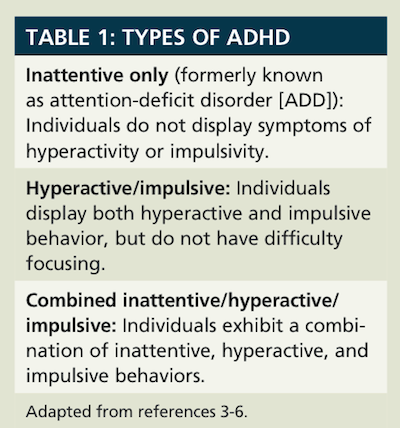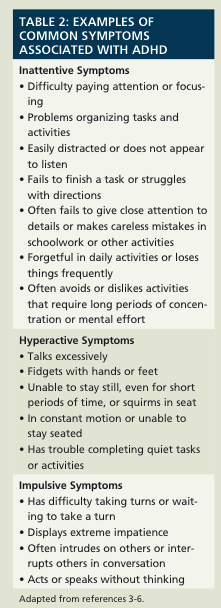Article
Living with ADHD
Author(s):
Although attention-deficit/hyperactivity disorder is a long-term condition, it can be managed with proper treatment.
Although attention-deficit/hyperactivity disorder is a long-term condition, it can be managed with proper treatment.
Attention-deficit/hyperactivity disorder, also called ADHD, is considered to be one of the most common behavioral disorders among children; however, teens and adults may also have ADHD. The Centers for Disease Control and Prevention estimates that 6.4 million children between 4 and 17 years of age have ADHD, and the number continues to rise each year.1 ADHD typically continues through adulthood and affects an estimated 8 to 9 million adults in the United States.2
Causes and Risk Factors
ADHD appears to be more common in boys than girls. While the exact cause of ADHD is still not known, recent research has shown that this disorder may be linked to genetic factors and environmental factors, such as excessive exposure to lead or other toxins.3-6 Studies involving twins suggest a genetic link to ADHD.5 Premature birth, low birth weight, and significant head injuries may also increase the risk of developing ADHD.3-6
What Are the Symptoms of ADHD?

The symptoms of ADHD can be categorized into 3 groups: inattentiveness, hyperactivity, and impulsivity (Tables 1 and 2).3-6 When first evaluated by a health care provider, most patients with ADHD primarily have symptoms of inattentiveness; some patients also have a combination of hyperactive and impulsive symptoms.

If you suspect that your child has ADHD, talk to your primary health care provider about having your child evaluated. No single test can diagnose ADHD. Typically, a health care professional makes a diagnosis through a multistep evaluation because many other conditions, such as depression, anxiety, and learning disabilities, have symptoms similar to those of ADHD. Most children with ADHD have at least 1 other developmental or behavioral problem. The American Academy of Pediatrics’ recommendations and diagnostic guidelines for ADHD in children 4 to 18 years of age can be found at http://www.healthychildren.org/English/health-issues/conditions/adhd/pages/AAP-Recommendations-Diagnostic-Guidelines-for-ADHD.aspx
ADHD in adults may be difficult to diagnose. A health care provider will want to know if you had ADHD symptoms during childhood and will perform a thorough evaluation to determine whether you have ADHD.
Treatment
Various treatment options are available for managing ADHD. Your health care provider will determine the best treatment plan. Treatment may include medication and/or behavioral therapy. The most commonly prescribed drugs for treating ADHD are psychostimulants, such as methylphenidate and amphetamines.4,5 Additionally, the nonstimulant drug atomoxetine is FDA approved for treating ADHD.4,5
Therapy is generally tailored to provide the most effective results for each patient. Although the medications will not cure ADHD, they can help control the symptoms if the patient takes the medications as directed by the health care provider. If medication is prescribed, it is important to contact your health care provider if you have any concerns about, or adverse effects from, the medication.
Behavioral therapy, which is designed to increase focusing skills, is often used to help patients control behavior and become better organized.
Living with ADHD
Although ADHD is a long-term disorder, the good news is that with proper treatment, it can be managed. Left untreated, it can negatively affect schoolwork, job performance, and family and social relationships. Parents and caregivers can help their child by being supportive; praising good behavior; limiting environmental distractions; and ensuring that their child gets an adequate amount of sleep, eats a balanced and nutritious diet, and maintains a consistent and organized schedule.
Several organizations provide education and support for patients and families affected by ADHD (Online Table 3). Increasing awareness and knowledge about recognizing and treating ADHD is important for improving the quality of life of patients with ADHD.
Table 3: ADHD Educational Resources
- Centers for Disease Control and Prevention Kids' Quest ADHD website: www.cdc.gov/ncbddd/kids/adhd.html
- CHADD (Children and Adults with Attention-Deficit/Hyperactivity Disorder) website: www.chadd.org
- National Resource Center on ADHD website: www.help4adhd.org
- Attention Deficit Disorder Association website: www.add.org
- ADHD Aware website: www.adhdaware.org
- National Institute of Mental Health Attention Deficit Hyperactivity Disorder website: https://www.nimh.nih.gov/health/publications/adhd-listing.shtml
Ms. Terrie is a clinical pharmacist and medical writer based in Haymarket, Virginia.
References:
- Attention deficit/hyperactivity disorder. Centers for Disease Control and Prevention website. www.cdc.gov/ncbddd/adhd/data.html. Accessed February 8, 2014.
- ADHD fact sheet. Attention Deficit Disorder Association website. www.add.org/?page=ADHD_Fact_Sheet. Accessed February 8, 2014.
- Attention deficit hyperactivity disorder. National Institute of Mental Health website. https://www.nimh.nih.gov/health/publications/adhd-listing.shtml. Accessed February 8, 2014.
- Attention deficit hyperactivity disorder. Medline Plus website. www.nlm.nih.gov/medlineplus/ency/article/001551.htm. Accessed February 8, 2014.
- Facts about ADHD. Centers for Disease Control and Prevention website. www.cdc.gov/ncbddd/adhd/facts.html. Accessed February 8, 2014.
- Understanding ADHD: information for parents about attention-deficit/hyperactivity disorder. American Academy of Pediatrics website. http://patiented.aap.org/content2.aspx?aid=6050. Accessed February 8, 2014.






